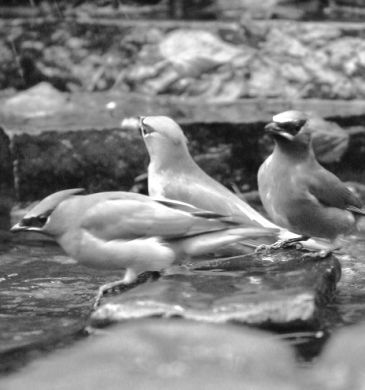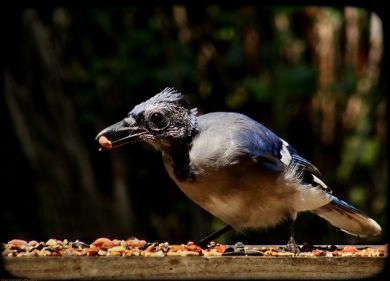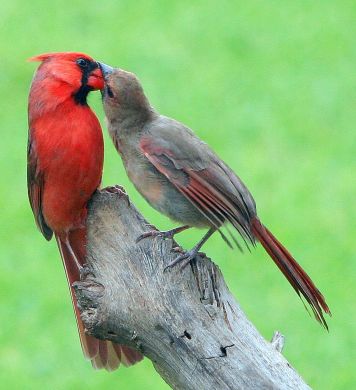Blog - General
Dave’s 2013 July Bird Chatter
After the cool spring weather relented and it finally warmed up, our migratory birds finally made it to their nesting grounds. Wrens seem to be successfully nesting. Purple Martins are fledging their young, and Bluebirds appear to be having a good season with many folks enjoying them for the first time after installing nest boxes. Many people have Orioles, Rose-breasted Grosbeaks, and finches gracing their yards. The length of time they visit the bird feeders depends on where you live and how vigilant you are watching to see who is visiting your well stocked bird feeders. Summer bird feeding has been most enjoyable with a good variety of birds visiting a variety of well stocked feeders. As normally happens when the weather turns hot and humid the amount of food and frequencies of birds visiting your feeders may subside a bit. Hot weather saps the appetite of birds reducing the amount of food they need. This type of weather also makes many animals including humans lethargic. On these hot days the birds will feed early in the day and again late in the afternoon to early evening avoiding the midday heat. You may witness some birds on the ground in shady areas with wings spread and beaks wide open. This is one way, other than bathing, to cool down a little. Birds lack sweat glands and will pant much like a dog to relieve heat buildup in the body.
installing nest boxes. Many people have Orioles, Rose-breasted Grosbeaks, and finches gracing their yards. The length of time they visit the bird feeders depends on where you live and how vigilant you are watching to see who is visiting your well stocked bird feeders. Summer bird feeding has been most enjoyable with a good variety of birds visiting a variety of well stocked feeders. As normally happens when the weather turns hot and humid the amount of food and frequencies of birds visiting your feeders may subside a bit. Hot weather saps the appetite of birds reducing the amount of food they need. This type of weather also makes many animals including humans lethargic. On these hot days the birds will feed early in the day and again late in the afternoon to early evening avoiding the midday heat. You may witness some birds on the ground in shady areas with wings spread and beaks wide open. This is one way, other than bathing, to cool down a little. Birds lack sweat glands and will pant much like a dog to relieve heat buildup in the body.
This is vacation time for many families and individuals. Trips are being planned for traveling to other parts of the country and geological locations. You are sure to see a change in the variety of bird species you will encounter, even if you are not out actively bird watching. This includes a simple trip across Nebraska where you’ll pass through a variety of different ecological regions. And once you enter into the more than 19,000 square miles of Sandhills and on into Western Nebraska you will see a variety of western bird species that do not occur in the eastern part of the state. These, along with the major migratory flyways that pass through the state, make Nebraska one of the top bird watching regions on the northern continent. So at the Wild Bird Habitat Stores we encourage everyone to have a field guide and familiarize yourself with it. Take along binoculars if you have them or consider investing in a quality pair of Vortex optics available at the Wild Bird Habitat Store in the Alamo Plaza. Even if traveling to far off places, other countries, we can get a bird identification guide specific to any state or country. Honing your skills for using a field guide now will make it easier to identify birds passing through your yard during fall migration which is not too far off.
By late July into August you might start noticing some “bald” birds. This seems most common in Cardinals, Blue Jays, and blackbirds. This baldness is caused by feather mites and does not harm the birds but may cause them some embarrassment. These mites clip off the feathers on the head at the skin line which do not grow back until the fall molt. Again there is no cause for alarm as it is harmless to the birds and does not affect humans.
July begins the primary nesting period for the American Goldfinches and Cedar Waxwings. This period coincides with the ripening of certain plants that provides fibrous materials for constructing nests as well as seeds and berries for each of these species young. Goldfinch for example feed their nestlings strictly seed after hatching and mid-summer provides a hearty bounty of these food products. Waxwings not only feed their young insects that have become plentiful by now, many of which are considered pests, but the berries and fruits on a variety of shrubs and trees have ripened offering additional food sources.
One of the most enjoyable aspects of summer bird feeding is watching the adult birds bringing their young to the backyard bird feeders. What a delight to sit outside on the deck or patio and watch these dedicated parents take care of their offspring while these fledglings go about exploring this mysterious world. Just to watch these youngsters explore water for the first time is a treat. But they learn quickly. Life in the wild depends on the ability to learn fast.
 Over the past few weeks the onslaught of young birds my wife and I have enjoyed watching in the backyard is typical if you maintain the bird feeders, have some natural habitat, and a good source of water. We have seen; Chickadees feeding Nutra-Saff Safflower seed to their newly fledged babies, the adult male Cardinal busily feeding his two youngsters while the female is probably starting a second brood. The male Downey Woodpecker working hard to keep up retrieving suet from the suet feeder for his fledglings and occasionally treating them to bits of shelled peanuts. And one of my favorites is the Red-bellied Woodpecker who takes advantage of exploiting every type of food we provide for the birds. From foraging for insects along the tree bark to suet then peanuts in the shell, their young have a very diverse diet. The best all-around woodpecker feeder we have other than the suet feeders are the caged feeders which all woodpeckers can freely feed from, but grackles and squirrels cannot. We’ve watched baby Blue Jays, Robins, House Finch, and many others visit our yard so far this summer for food, water, and shelter. What a perfect way to relax and reflect on the day’s events. Watching or being in nature just a few minutes each day has been documented to relieve stress. Maybe you know a friend that could use a little backyard birding stress relief.
Over the past few weeks the onslaught of young birds my wife and I have enjoyed watching in the backyard is typical if you maintain the bird feeders, have some natural habitat, and a good source of water. We have seen; Chickadees feeding Nutra-Saff Safflower seed to their newly fledged babies, the adult male Cardinal busily feeding his two youngsters while the female is probably starting a second brood. The male Downey Woodpecker working hard to keep up retrieving suet from the suet feeder for his fledglings and occasionally treating them to bits of shelled peanuts. And one of my favorites is the Red-bellied Woodpecker who takes advantage of exploiting every type of food we provide for the birds. From foraging for insects along the tree bark to suet then peanuts in the shell, their young have a very diverse diet. The best all-around woodpecker feeder we have other than the suet feeders are the caged feeders which all woodpeckers can freely feed from, but grackles and squirrels cannot. We’ve watched baby Blue Jays, Robins, House Finch, and many others visit our yard so far this summer for food, water, and shelter. What a perfect way to relax and reflect on the day’s events. Watching or being in nature just a few minutes each day has been documented to relieve stress. Maybe you know a friend that could use a little backyard birding stress relief.I urge all to set aside a few minutes every day and watch the birds attracted to your yards whether you feed all summer long or not. Even for those folks that do not feed birds, the phenomenon of bird life around us is ancient. These creatures have evolved over millions of years and continue to adapt to the challenges of living in a human world. Let’s hope, pray, and support those birds that for eons have migrated to far off places for the winter only to return to northern areas to raise a family in summer will continue their journey’s for millennium. That birds will continue to grace our yards and gardens for years to come. These feathered creatures entertain and amaze us. Birds are so unique there are many aspects of their lives we have yet to understand. The birds all across our planet continue to be one of the greatest gifts and resource that has the ability to connect humans with nature on a daily basis.
If you have a bird bath be sure to keep it clean and supplied with fresh water daily. This is important to all birds. If the weather becomes dry this summer, and we certainly could use a break from the rains, it will be a welcome oasis for many wild creatures. This is a good spot to observe social behavior between birds of the same and different species. Keeping your bird bath in a shady area will help to reduce algae build-up. Sunlight is what promotes the growth of algae. Most plastic, resin, or ceramic bird baths can be easily clean with a bit of vinegar. For porous bird baths, such as concrete, a weak solution of Clorox and water will not only clean out the gunk, but kill the algae spores lodged in the concrete itself. Just make certain to give the bath a good rinsing after treatments.
Thank you for supporting the Wild Bird Habitat Stores for the past 20 years and we hope to continue to serve you. Good birding to you all. Dave Titterington
